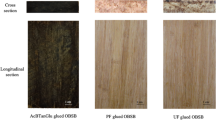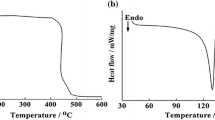Abstract
Wattle tannin adhesives were successfully formulated from tannin extracts, which were commercially produced from black wattle (Acacia mearnsii) bark in China. Using the Chinese wattle tannin adhesives a total of 153 plywood panels were prepared in order to study effects of pH, paraformaldehyde, glue spread, hot pressing temperature and time, and closed assembly time on bonding strength and their bonding quality was assessed according to the Chinese Standard for exterior grade plywood. Statistical analysis results revealed that Chinese wattle tannin can be used for producing exterior grade plywood under Chinese plywood factory conditions. One of the specific characteristics of these Chinese wattle tannin adhesives was that their use resulted in plywood of high quality bonding over the wide range of closed assembly time from 30 minutes to 16 hours. These Chinese wattle tannin adhesives have a great potential for commercialization in China.
Zusammenfassung
Aus Akazientannin, das in China kommerziell aus der Rinde von Acacia mearnski extrahiert wird, konnten geeignete Sperrholz-Kleber gewonnen werden. Mit diesem Kleber wurden 153 Sperrholzplatten hergestellt. Daran wurde der Einfluß von pH, Paraformaldehydmenge, Leimverteilung, Preßtemperatur und Preßzeit sowie der Schließzeit auf die Festigkeit der inneren Bindungen untersucht. Die Prüfung erfolgte nach dem chinesischen Standard für Außenverwendung von Sperrholz. Statistisch gesichert erwies sich das Akazientannin als geeignet zur Herstellung von Sperrholz für die Außenverwendung. Eine characteristische Eigenschaft dieser Kleber war, daß über einen weiten Bereich von Schließzeiten (von 30 min. bis 16h) Sperrholz von hoher Bindungsqualität hergestellt werden kann. In China dürften diese Kleber einen hohen Marktwert erreichen.
Similar content being viewed by others
References
Dalton, L. K. 1950: Tannin formaldehyde resins as adhesives for wood. Australian Journal of Applied Science, 1: 54–70
Dalton, L. K. 1953: Resins from sulphited tannins as adhesives for wood. Australian Journal of Applied Science, 4: 136–154
Pizzi, A. 1983: Tannin-based wood adhesives. In: Pizzi, A. (ed.) Wood Adhesives Chemistry and Technology, New York: Marcel Dekker, Inc. 177–246
Plomley, K. F. 1966: Tannin-formaldehyde adhesives for wood. II. Wattle tannin adhesives. CSIRO, Division of Forest Products Technol. Pap. No 39, pp. 1–16
Guangcheng, Z.;Yunlu, L.;Yazaki, Y. 1988: Comparing molecular size distribution of tannin extracts fromAcacia mearnsii bark from different countries. Holzforschung 42(6): 407–408
Author information
Authors and Affiliations
Additional information
This work was supported by the Australian Centre for International Agricultural Research (ACIAR). The authors would like to acknowledge Professor Ho Chin-ko and Director Mr Zhang Zonghe for their understanding and support at the Research Institute of Chemical Processing and Utilization of Forest Products, Chinese Academy of Forestry, Nanjing, People's Republic of China. The statistical analyses were carried out by Dr N. K. Nguyen at CSIRO-IAPP Biometric Unit, Melbourne, Australia.
Rights and permissions
About this article
Cite this article
Zhao, L., Cao, B., Wang, F. et al. Chinese wattle tannin adhesives suitable for producing exterior grade plywood in China. Holz als Roh-und Werkstoff 52, 113–118 (1994). https://doi.org/10.1007/BF02615476
Issue Date:
DOI: https://doi.org/10.1007/BF02615476




